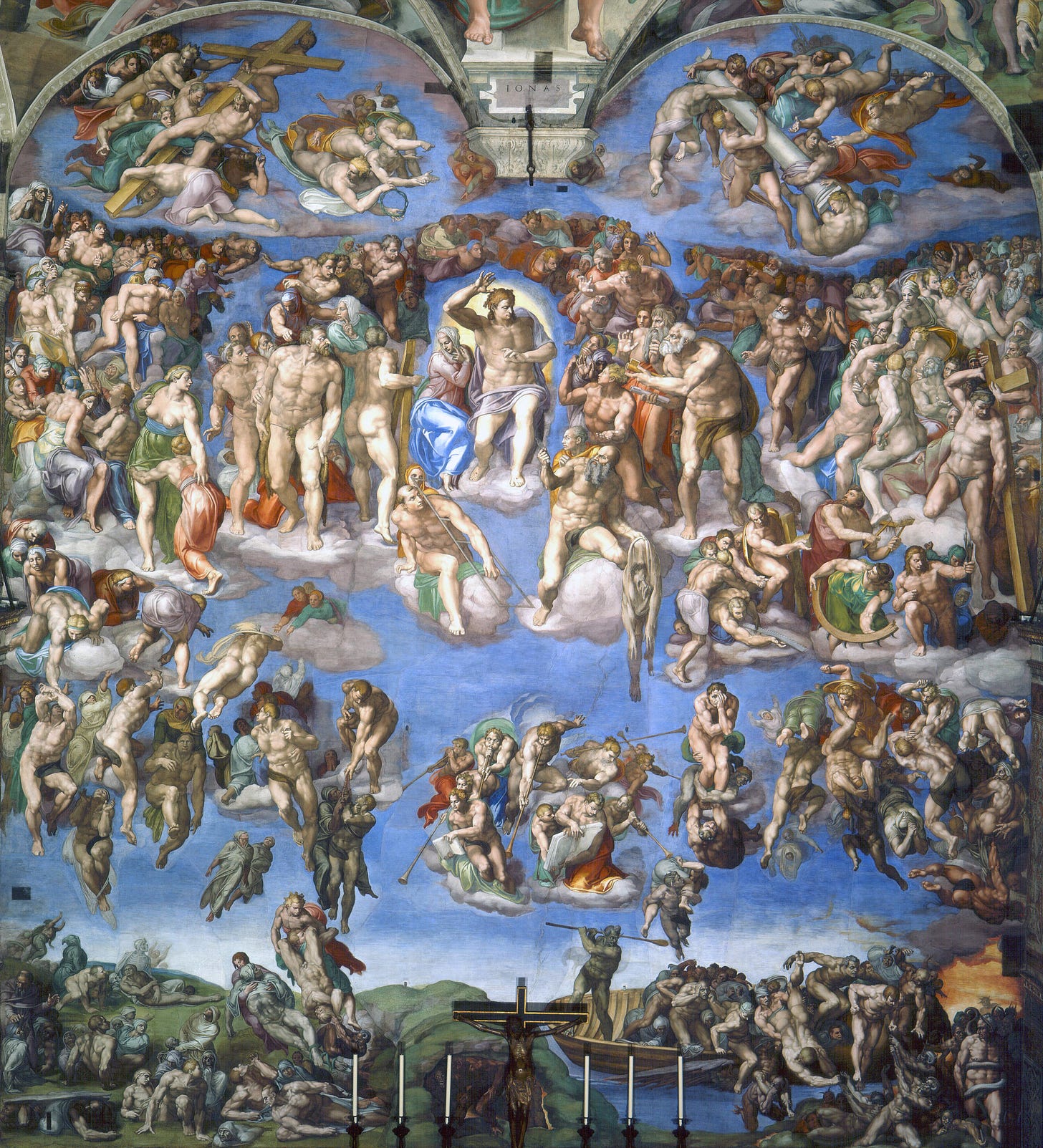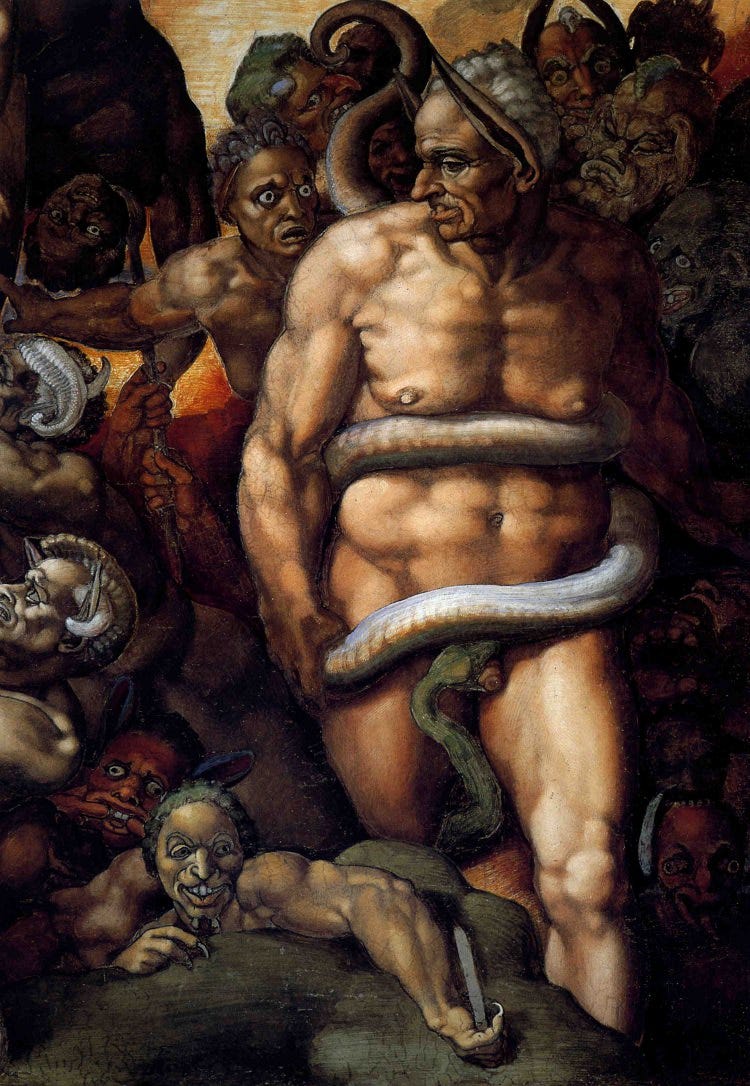God Bless Good Pettiness
Artists are dissenters and activists, & it would be my joy to explain. 🎨

This is a story of art, pettiness, subversion, and wit, and it all hails from the life of Michelangelo.
Michelangelo famously painted the Sistine Chapel.
What many people don’t know is that Michelangelo didn’t want to paint the Sistine Chapel. He didn’t consider himself a painter. He identified as a sculptor, but when multiple popes ask you to paint the Sistine Chapel, what are you gonna do?
He was commissioned to paint the Sistine Chapel twice. The first time he was reluctantly commissioned by Pope Julius II. There’s some speculation that Julius wanted to sabotage Michelangelo (a story for another day). But Michelangelo completed his fresco on the ceiling between 1508 and 1512. He was then commissioned the second time (reluctant again) decades later by Pope Clement VII (finished and overseen under Pope Paul III), painting the west wall from 1536 to 1541. Our story concerns the latter fresco titled The Last Judgment.
Like other art of this time period, nudity was normal and increasingly so since the emergence of the Renaissance. Michelangelo himself was known for nude artistic work, having sculpted his statue David from 1501 to 1504. Thus, it isn’t surprising that Michelangelo included nude figures in his frescoes. The story goes that there was a “master of ceremonies” named Biagio Martinelli (or Biagio da Cesena) who came with Pope Paul III to view Michelangelo’s progress with The Last Judgment. Biagio saw the nude figures and scoffed, saying that Michelangelo’s work was not becoming of a place of honor. The fresco was painted on the wall behind the altar. Biagio’s point was that, when gazing at the altar, communicants and others would be viewing so much genitalia. So, Biagio told the Pope, God, and everyone that Michelangelo’s work was dishonorable, more befitting for a brothel.1
This is when I imagine Michelangelo felt a little petty. He took offense with Biagio’s comment. Remember: Michelangelo is a master who preferred sculpting. He reluctantly left his home in Florence to accept these commissions. And in the middle of his work, Biagio, a master of ceremonies, was dunking on Mike’s work. So, Michelangelo created his own 16th-century diss track. 👀
The Last Judgment is a bit chaotic. There’s a lot going—lots of folks being judged. Christ, the Apostles, and other important folks are centered at the top. You’ll see even St. Bartholomew (or Nathanael) holding his own “flayed skin.” (You should zoom in on the image below. It’s wild.) For our story, though, focus on the bottom right of the painting. Here you can see a figure in a boat.
This figure is supposedly Charon of Greek mythology pulling double-duty in the ultimate Christianity crossover. He’s painted ferrying souls to the gates of hell. Satan, though, isn’t the one to receive the souls. Nay nay. Instead, it is the character of Minos who Dante writes about in the Divine Comedy.

In the Divine Comedy, Minos received the souls of the damned, weighed them, and judged which circle of hell they would live in for eternity by wrapping his tail around them. If the tail circled around a soul, say, seven times, they would live in the seventh circle of hell.2 Minos is the figure with donkey ears at the most bottom right of the fresco (enlarged below). In an ironic twist, this visualization of Minos has his own tail wrapped around himself. To go further, Minos’s tail is also a snake 🐍 , and the snake is biting Minos’s own genitalia. 😬
Why does this make Michelangelo petty? 👀 Well …
Michelangelo used Biagio’s likeness to paint Minos’s profile. Mike painted Biagio in hell. Biagio, as Minos, is visualized with donkey ears—a sign of ignorance. As Minos, Biagio has judged himself by wrapping his tail around himself twice. This corresponds with the second circle of hell; in Dante’s Inferno, the second circle represents the sin of lust. Biagio made comments about nudity in Michelangelo’s paintings. So, Michelangelo was going to paint his commentary on how he interpreted Biagio’s adamance for hiding nudity in art. “Obsessed much? Maybe you’re lustful.” And because Biagio complained about nudity during the preview, Michelangelo exercised another chance to be petty. Does Michelangelo paint Biagio’s bits and bobs in the fresco for all to see? No. Mike hid Biagio’s bits via snake bite.
The LAYERS! Petty level, expert. 💅
That’s not all. Biagio, complainer he was, did complain to Pope Paul III. He asked Pope Paul III to have his likeness removed from the painting. Pope Paul III supposedly had a bit of a laugh and said “if Angelo had put [Biagio] into Purgatorie, [the Pope] then had power in himself to have released [Biagio] thence, but being it was into hell, it was beyond [the Pope’s] jurisdiction.”3
Maybe Pope Paul III was a little petty, too.4 💅
The chef’s kiss? If you Google “Biagio de Cesena” today (484 years after the fresco was completed), you immediately get this story and find image after image of Biagio as Minos. We love. 🫶
Art as Dissent
Like many of you, I’m thinking through my own work and the direction of my activism for the next several years. Like Michelangelo, I am also somewhat of a gig-worker. I make pitches, take commissions, fill out my W9s, report 1099s, and collaborate with folks throughout each year. When I often collaborate with others, they’ll request I send over a short bio. The first line of my bio reads: “Jenai Auman is a writer, artist, and author of Othered.”
I do spend time posting and writing on the internet, and I may appear to be a “content creator” or “influencer,” particularly for those who are prone to reductive categories, but I resonate with Michell C. Clark’s words from a Threads post some weeks back.
“I choose to define myself as an artist.”
For me, being an artist is like putting on my favorite coat. For those who find the work meant for them, the fit is *just right*. The Goldilocks zone of vocations. From the likes of Michelangelo and, more specifically, creative women and female mystics who created a body of spiritual artwork and writing throughout church history, these stories reveal a subversive tradition. A rich heritage. One where others had fun, challenged those in power, and found moments of delight, too, even if a touch petty.
Michelangelo painted, but he considered himself a sculptor. My work often looks like content creation, but I consider myself an artist. I send words into the world with purpose because there are many words shared in the world without purpose. Or, worse, the words often sent out into the world are sent to harm. Like Mike, I resist and dissent against my own Biagios who hoot and holler while overly involved in policing the lives and work of others.
I dare to think that, in subverting the powers and principalities perpetuating injustice in the world, God blesses your shalom-fostering, truth-telling pettiness.
Staying Connected to Art
Because I’ve identified as an artist, I occasionally get asked how being an artist is linked to my vocation as I do work in other spheres and arenas. How does art integrate with what Frederick Buechner would call the place where my “deep gladness and the world’s deep hunger meet”?5 How do I create when, in our current cultural moment, art is ill-valued in the world and hard to make a living off of.
Let me share a response I recently sent to a former writing mentee:
If you want to create art to share with the world, it’s helpful to understand your own connection to art. My personal connection is that I create because I’m a creator who was made to image my Creator. I don’t create because I am a “content creator.” I make art because I’m an artist; making art is a part of my holy alignment. It is a part of me staying integrated. Whole. The act of creation is a part of my healing. The desire or urge to create has everything to do with how I was created and who I was created to become. Shalom with myself and with God is staying in alignment with who God has made me to be. This is different, separate, and distinct from finding a sense of satisfaction based on how well-received my art is or isn’t.
Artists have historically been activists. They see the fractures formed from systemic injustices and are willing to exercise their imagination to dream about what wholeness could look like. The work of art is to help others see layers of truth—especially layers that are harder to receive and accept in other ways. So, artists are prophets, and prophets are usually not well-received by folks in power. Thus, pursuing art as a profession is hard for many.
So, my encouragement? Make art because you can’t not make art. Make art because it is like breathing—a part of who you are. And if you’re vulnerable and brave enough to put your art out in the world, you may find a community of folks who support you in your artistic endeavors.
Good Art vs. Bad Art
A cautionary tale? Some artists become successful because, rather than boldly pointing to the truths within their culture, they pander to the dominating culture. Art that panders is propaganda. It is bad art. Madeleine L’Engle has a few words on this. In her book Walking on Water, she writes, “If it is bad art, it is bad religion, no matter how pious the subject.”6 Bad artists use piety to pander to the powerful. It’s how political leaders can use God’s name while looking nothing like the person of Jesus.
What is “good art”? Art that tells the truth. Good art is a part of the continuing revelation of truth. Emily Dickinson wrote, “Tell the truth but tell it slant.” This is an encouragement not to bend the truth, but to tell it from a new angle. Give the people something new to see. Highlight a long-ignored crack. Delight them. Surprise them. Challenge them. Be bold enough to disagree and be disagreed with. And like Michelangelo, be maliciously compliant when your own Biagio believes you are too much or not enough.
In the words of the inimitable James Baldwin, “Artists are here to disturb the peace. They have to disturb the peace. Otherwise, chaos.”
Our current cultural moment in the United States doesn’t change my work. Does the state of the U.S. make me mad? Livid? Absolutely. Opening the news is a choice to come face to face with more heartbreak. Peace as defined by those in power is a compliant, malformative sort of peace. It isn’t the shalom of God. My work didn’t change with the inauguration of a new U.S. president. The work is the same. My vocation is to foster wholeness. A holistic shalom. To do so, I know whose peace I need to disturb.
Fellow artists and creative activists: Create. Resist. Dissent. Subvert. Be offended. Find your petty.
Disturb faithfully. 🌾
Updates
Substack is giving me the side-eye because “this post is getting too long for email.”
I’ll send a bonus post later this month on updates on the Courageous Women shirt and more info for those who leave reviews/ratings for Othered on Amazon.
This comment on brothels was communicated to Michelangelo as a place of dishonor juxtaposed with the place of honor that was/is the Sistine Chapel. I, personally, hold more nuance than judgment for those engaged in sex work, particularly as it is widely understood as the oldest occupation women have turned to for survival. I do not intend personal judgment in this story, but I am aiming to stay true to what has been communicated to Michelangelo.
I wanted to briefly note, I do not subscribe to Dante’s ideas of “hell.”
I first learned of Michaelangelo’s The Last Judgment in a video I’ve since lost since my original deep dive into an art history wormhole, but I did my due diligence and found scholarly information on The Last Judgment written by Normal E. Land in “A Concise History of the Tale of Michelangelo and Biagio da Cesena,” (2013) found on JSTOR: https://www.jstor.org/stable/41955680. I have access through my seminary. If you would like to read but don’t have access, send me an email. I’m glad to share.
Also a brief note, I’m not a Pope Paul III fan girlie, nor am I espousing what the Catholic Church was doing at this time. Abuses of ecclesial power made the construction of St. Peter’s Basilica possible in the first place. That is perhaps a post for another time.
Frederick Buechner, Wishful Thinking: A Seeker’s ABCs (New York: HarperOne, 1993), 119.
Madeleine L’Engle, Walking on Water: Reflections on Faith and Art (New York: Convergent Books, 2001), 4.










I live to be as petty as this
I’m here for ALL. OF. THISSSSS.🔥🔥🔥
I keep a sticker on my bulletin board above my desk that says “artist and maker, not content creator.” When I get energetically clogged up bc the attention economy demands you feed it with the next, greatest piece of content for views that lasts 2.5 seconds…that saying reminds me to create and make art bc it’s who I am. It’s in me. Like you said, I can’t not do it.